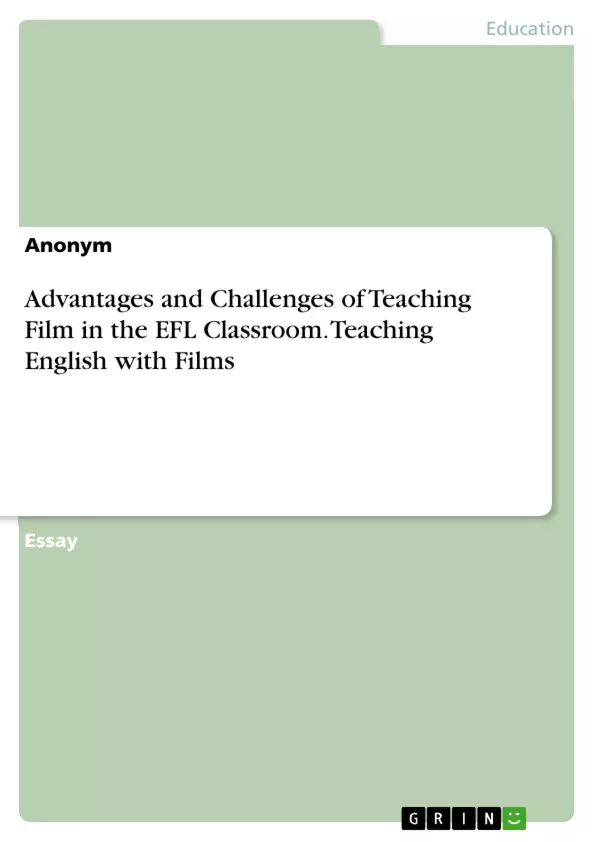In the following essay, the didactic usefulness of film in the classroom will be discussed theoretically, and the practical implementation and the challenges associated with it will be demonstrated using appropriate examples. The focus is on the treatment of films as they are shown in evening programs and cinemas.
The trend observed in recent years of integrating films more and more frequently into English lessons as aesthetic works of art in their own right, and referring primarily to the way the medium is made, means that films are unable to develop much of their potential. When using films today, the students are primarily required to deal with the different mechanisms of representation, such as camera perspective, editing, and montage. The language-promoting properties of films are often neglected. Furthermore, too much focus on the processes leads to a suppression of the film content, so that a
multitude of cultural aspects are neglected. Furthermore, the active involvement of the audience in the reception process is insufficiently considered. The potential of film used in English classes, which primarily pursues the "promotion of intercultural communicative competencies", will therefore be clarified in the following.
Inhaltsverzeichnis (Table of Contents)
- Introduction
- The Potential of Films in the English Classroom
- Relation to the World
- Foreign-language Films as a Cultural Product
- Audio-Visual Literacy
- Accompanying Challenges of Using Films in the EFLC
- Time Management and the Learning Effect
- The "Communication Challenge"
- Practical Part
- Example for a Possible Film Choice
- A Small Teaching Proposal
- The Disadvantages of Using Films in the English Classroom and Possible Solutions
- Conclusion
Zielsetzung und Themenschwerpunkte (Objectives and Key Themes)
This paper aims to explore the benefits and challenges of using films as a teaching tool in English as a Foreign Language (EFL) classrooms. It examines the didactic potential of film as a medium, analyzes how films can enhance students' understanding of the target language and culture, and discusses the practical considerations and challenges of implementing film-based pedagogy.
- The didactic potential of films in EFL classrooms
- The role of films in promoting intercultural communicative competence
- The challenges of integrating films into EFL teaching
- The advantages of using films to foster audio-visual literacy
- The importance of film as a cultural product and its role in providing insights into foreign cultures and countries
Zusammenfassung der Kapitel (Chapter Summaries)
The introduction sets the stage by highlighting the growing significance of films in contemporary society and their potential as a teaching tool. It argues that films offer a more accessible and engaging medium for language learning compared to traditional literary works.
Chapter 2 delves into the potential of films in the EFL classroom, emphasizing their ability to connect with students' real-world experiences, promote intercultural understanding, and foster audio-visual literacy. It further explores how films can enhance receptive and productive communicative competences.
Chapter 3 addresses the challenges of integrating films into EFL teaching, focusing on issues such as time management, the "communication challenge," and the need for careful consideration of the impact of emotionally charged films on students.
Chapter 4 presents a practical part with an example of a possible film choice and a small teaching proposal. This section aims to demonstrate how film can be integrated into EFL lessons.
Chapter 5 explores the disadvantages of using films in the EFL classroom and proposes possible solutions. It acknowledges limitations and challenges, but also suggests strategies for maximizing the effectiveness of film-based pedagogy.
Schlüsselwörter (Keywords)
The paper focuses on key concepts such as EFL teaching, film-based pedagogy, intercultural communicative competence, audio-visual literacy, and the challenges and advantages of using films in the EFL classroom. It draws upon research findings and examples to support its arguments, providing a comprehensive overview of the potential of films as a valuable tool in language learning.
- Citar trabajo
- Anonym (Autor), 2020, Advantages and Challenges of Teaching Film in the EFL Classroom. Teaching English with Films, Múnich, GRIN Verlag, https://www.grin.com/document/1244981



